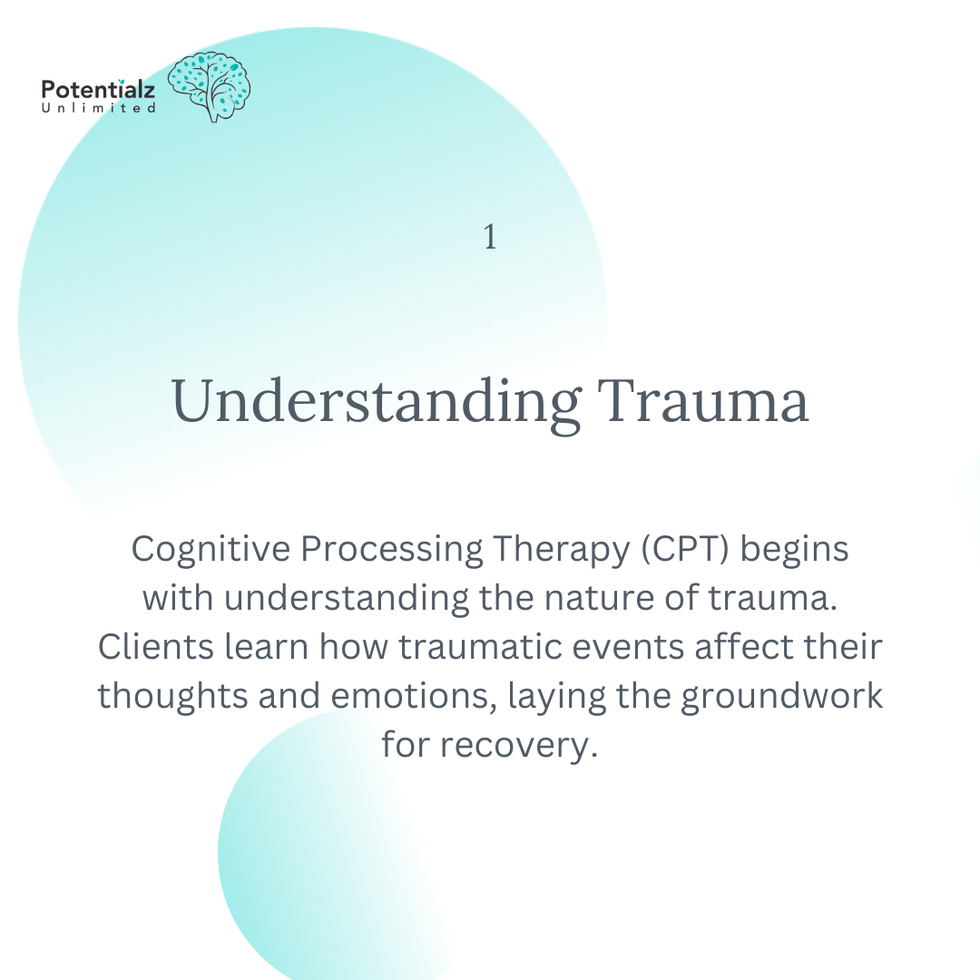Understanding How Cognitive Processing Therapy Helps Heal Trauma
- Gurprit Ganda

- Mar 18
- 4 min read

Trauma can leave people feeling broken, stuck in painful memories and emotions. Cognitive Processing Therapy (CPT) is a proven way to help people rebuild their lives after going through something terrible. Created by Dr. Patricia Resick, a psychologist, CPT helps people change the negative thoughts that keep them trapped in fear, guilt, or shame. This therapy gives people tools to understand their trauma, challenge unhelpful beliefs, and find hope again. Let’s break down how CPT works and why it’s so effective.
What Is Cognitive Processing Therapy?
CPT is a type of therapy that helps people with PTSD (post-traumatic stress disorder) or other trauma-related problems. PTSD can happen after someone experiences or witnesses a scary or life-threatening event, like abuse, violence, accidents, or war. People with PTSD often have:
Flashbacks (feeling like the trauma is happening again).
Nightmares.
Avoidance (staying away from places, people, or things that remind them of the trauma).
Negative thoughts about themselves or the world (e.g., “I’m worthless” or “No one can be trusted”).
CPT focuses on changing these negative thoughts. Think of your brain like a computer: trauma can install “bad software” that makes you see yourself or the world in unhealthy ways. CPT helps “reprogram” those thoughts.
How Does CPT Work?
CPT usually takes 12–15 sessions, either one-on-one or in a group. Here’s what happens step-by-step:
1. Learning About Trauma and PTSD
First, therapists explain how trauma affects the brain and body. For example:
Why nightmares happen: Your brain is trying to make sense of the trauma, even while you sleep.
Why you avoid things: Avoiding reminders feels safer in the short term but keeps you stuck in fear long-term.
This step helps people realize their reactions are normal, not “crazy” or weak.
2. Spotting “Stuck Points”
“Stuck points” are negative thoughts that keep you trapped. Examples:
“It’s my fault the trauma happened.”
“The world is 100% dangerous.”
“I can’t trust anyone ever again.”
In CPT, you learn to write down these thoughts and ask:
Is this thought true?
Is there evidence for and against it?
What’s a more balanced way to see this?
For instance, someone who survived a car accident might realize: “The crash was awful, but not every car ride will end in disaster.”
3. Writing About the Trauma
Talking or writing about the trauma is hard but important. Therapists guide you to:
Write a detailed story of what happened.
Write an “impact statement” about how the trauma changed your beliefs (e.g., “I used to feel safe, but now I’m always scared”).
This helps organize messy memories and reduces their power over you.
4. Challenging Negative Beliefs
CPT targets five key areas often damaged by trauma:
Core Belief | Trauma Distortion | Healthier Thought |
Safety | “Nowhere is safe.” | “Most places are safe most of the time.” |
Trust | “Everyone will hurt me.” | “Some people can be trusted.” |
Power/Control | “I’m powerless.” | “I can make choices to protect myself.” |
Self-Esteem | “I’m broken.” | “I’m stronger than I think.” |
Future | “My life is ruined.” | “I can heal and have a good future.” |
By practicing these new thoughts, people slowly rebuild confidence and hope.
What Happens in a CPT Session?
Phase 1: Getting Started
The therapist asks about your trauma history and PTSD symptoms.
You set goals (e.g., “I want to sleep without nightmares” or “I want to feel safe again”).
You learn how CPT works and agree to try it.
Phase 2: Building Skills
Over 8–10 sessions, you’ll:
Identify stuck points using worksheets.
Challenge all-or-nothing thinking (e.g., changing “I’m completely powerless” to “I can’t control everything, but I can control some things”).
Practice calming techniques, like deep breathing, to manage anxiety.
Phase 3: Moving Forward
In the final sessions, you:
Review progress and celebrate wins.
Make a plan to handle setbacks.
Say goodbye to the therapist (but can return if needed).
Why CPT Works So Well
1. Backed by Science
Studies show 60–80% of people no longer have PTSD after CPT.
Benefits last years, reducing depression, anxiety, and suicidal thoughts.
2. Works for Everyone
CPT helps:
Veterans and first responders.
Survivors of abuse, assault, or disasters.
Refugees and people from all cultures.
3. Short and Affordable
The 12-session format is cheaper than long-term therapy.
Group sessions cut costs further.
Cognitive Processing Therapy vs. Other Therapies That Help Heal Trauma
CPT Pros
Gives clear tools to change thinking.
Doesn’t require talking about the trauma in detail (unlike some therapies).
CPT Challenges
Facing tough emotions can be stressful at first.
Homework (like writing assignments) takes effort.
Real-Life Success Stories
Maria, a rape survivor, blamed herself: “I shouldn’t have walked alone at night.” Through CPT, she realized: “The attacker is to blame, not me. I can’t control others’ actions.”
James, a war veteran, believed: “I’m a monster for what I saw in combat.” CPT helped him see: “I did my best in an impossible situation. I’m not defined by my past.”
Conclusion
Trauma can make you feel stuck in the past, but cognitive processing therapy helps in healing your trauma. By changing unhelpful thoughts, you can rebuild trust, safety, and hope. As one survivor put it: “CPT didn’t erase my trauma, but it gave me the keys to stop letting trauma define me.”
Whether you’re a survivor or a loved one, remember: Healing isn’t about forgetting—it’s about rewriting the story you tell yourself. And that’s something everyone deserves.


































Comments